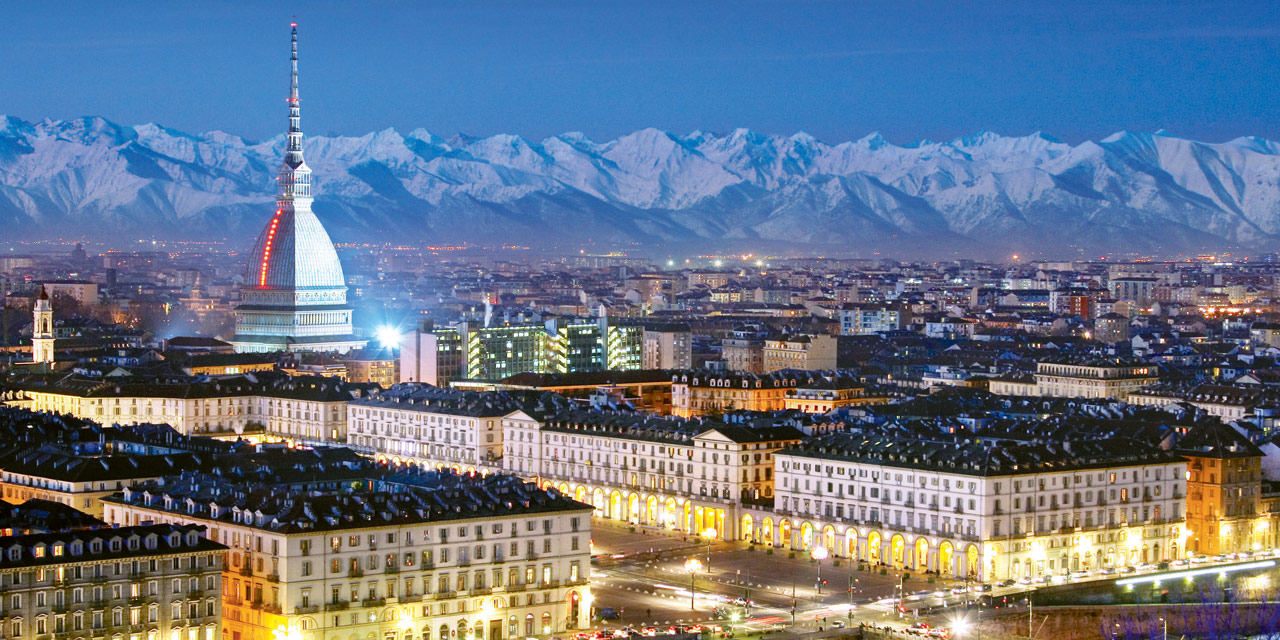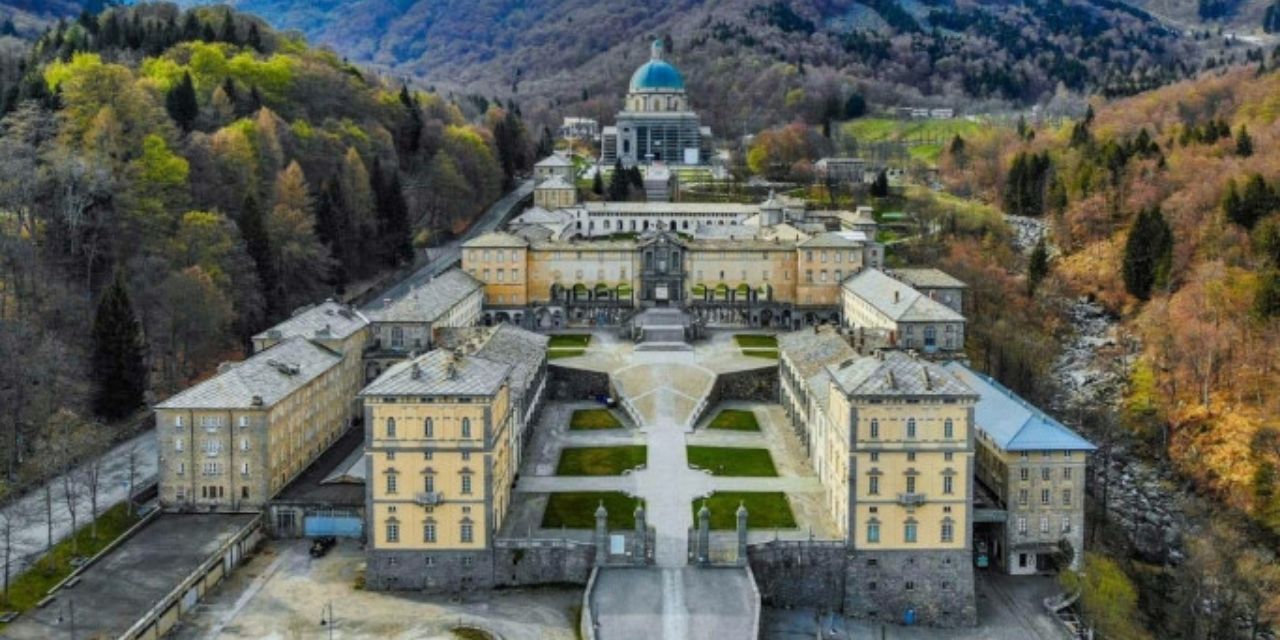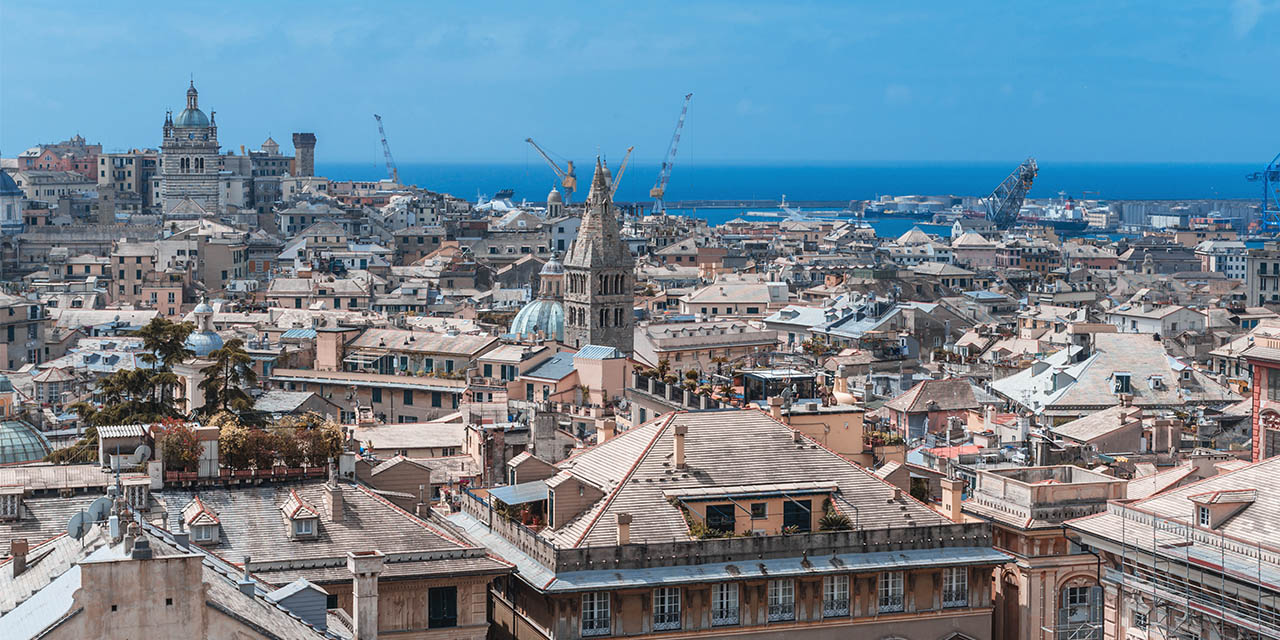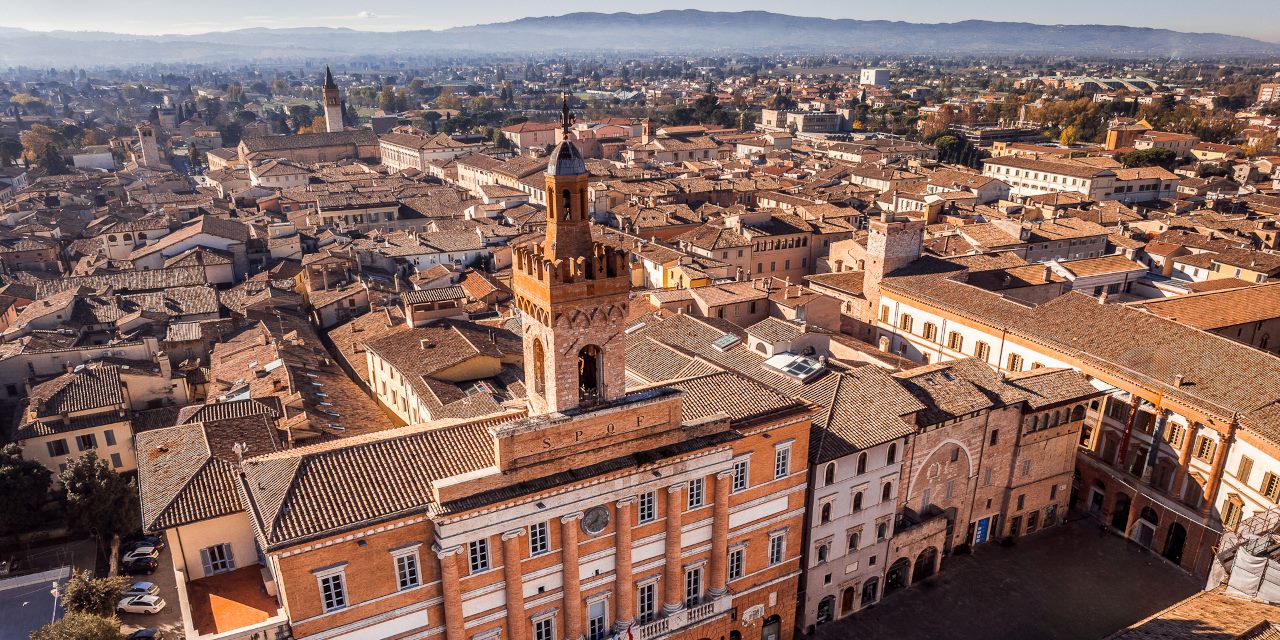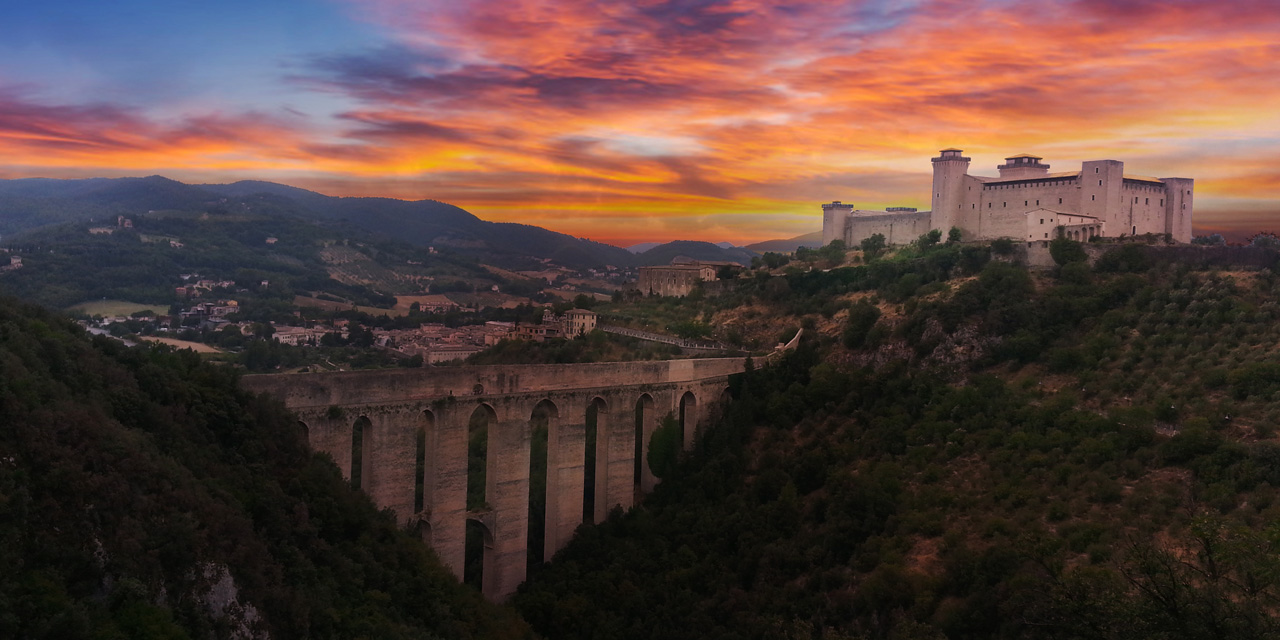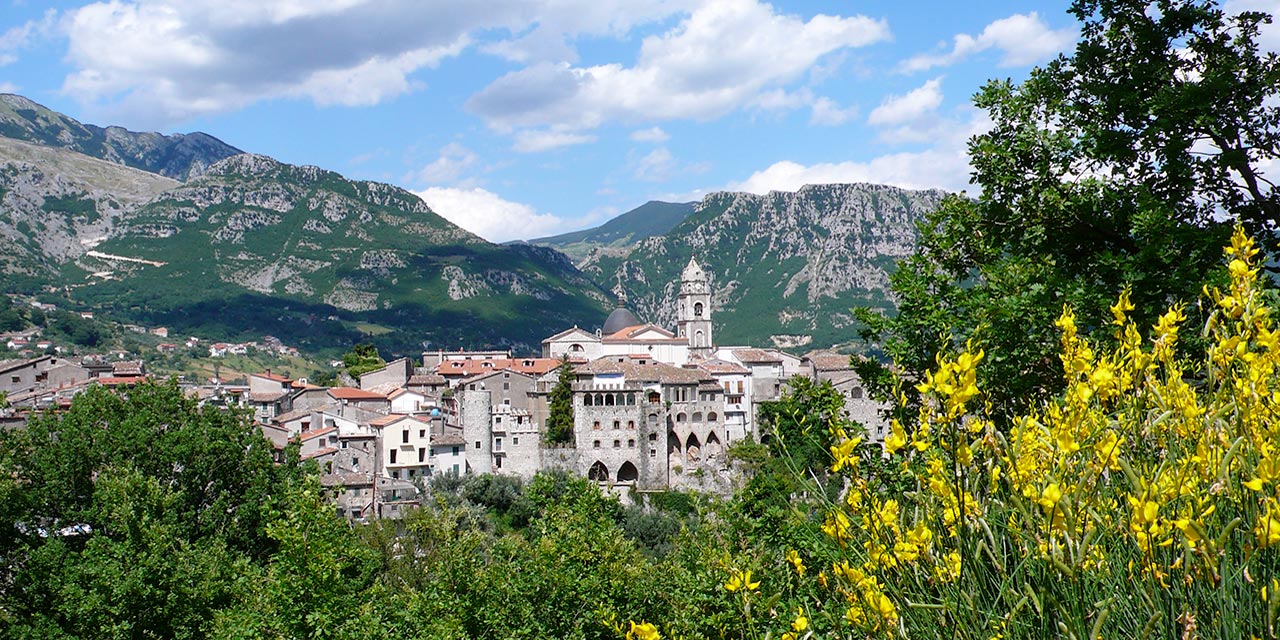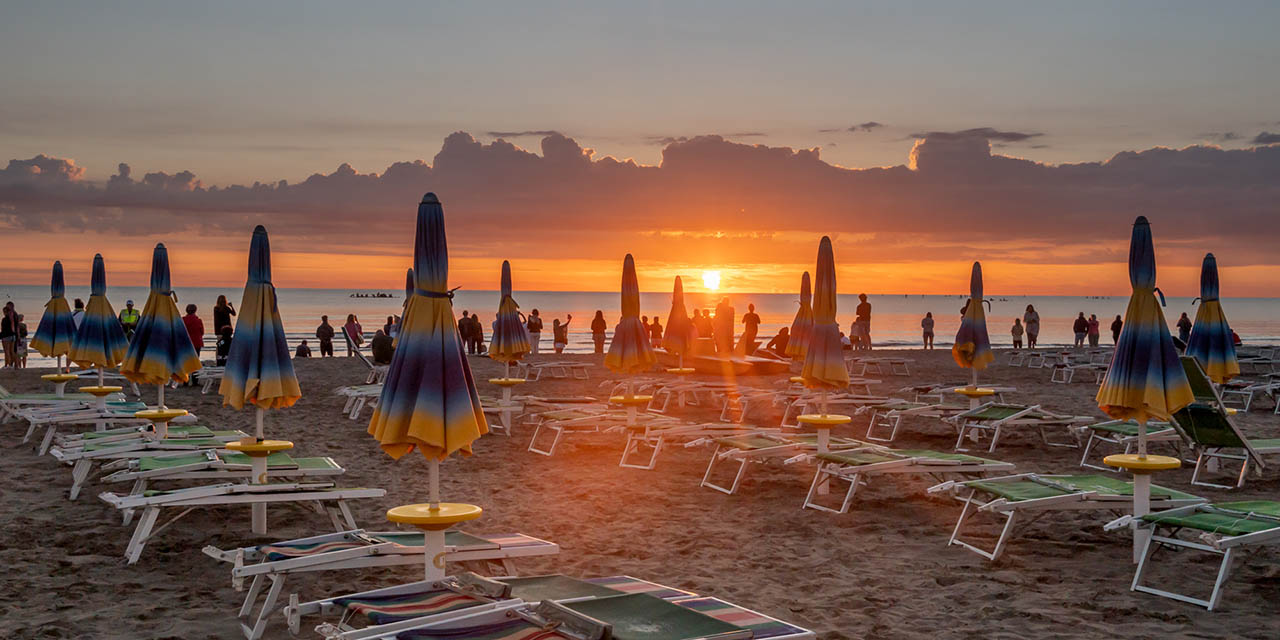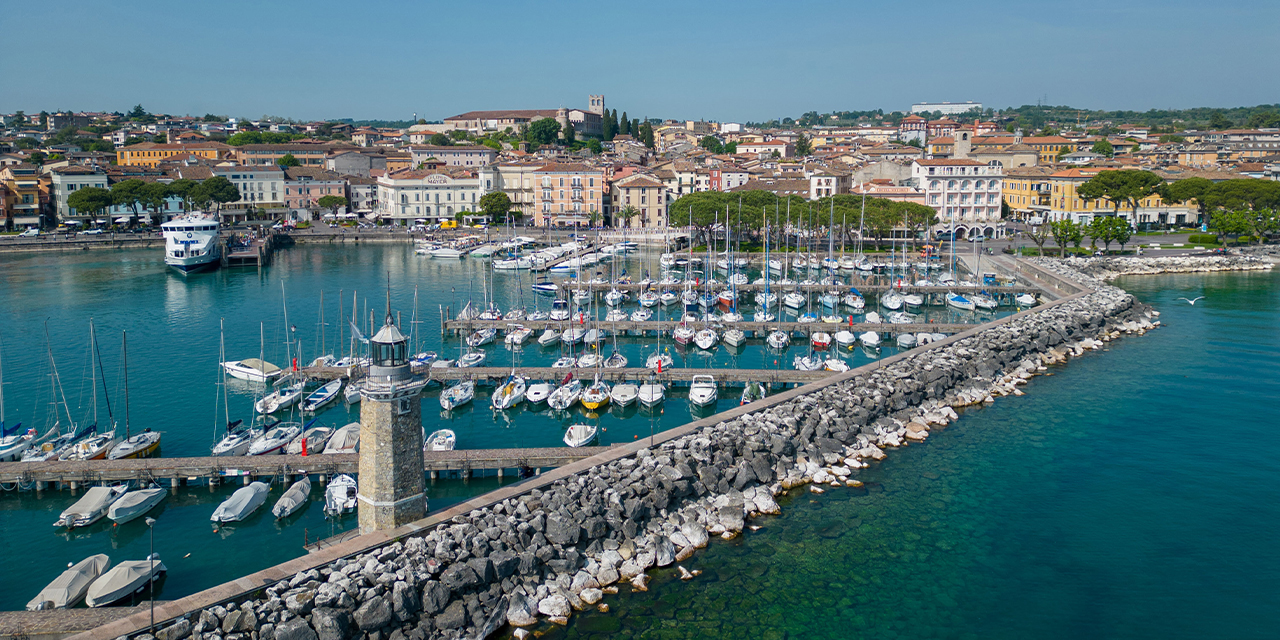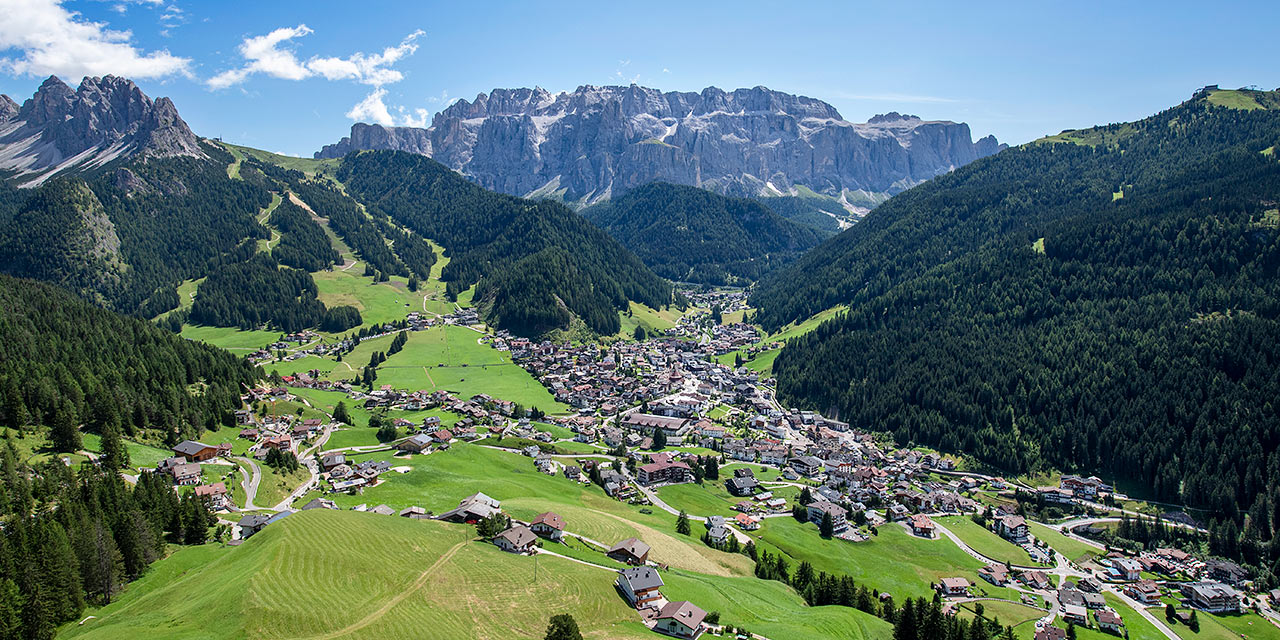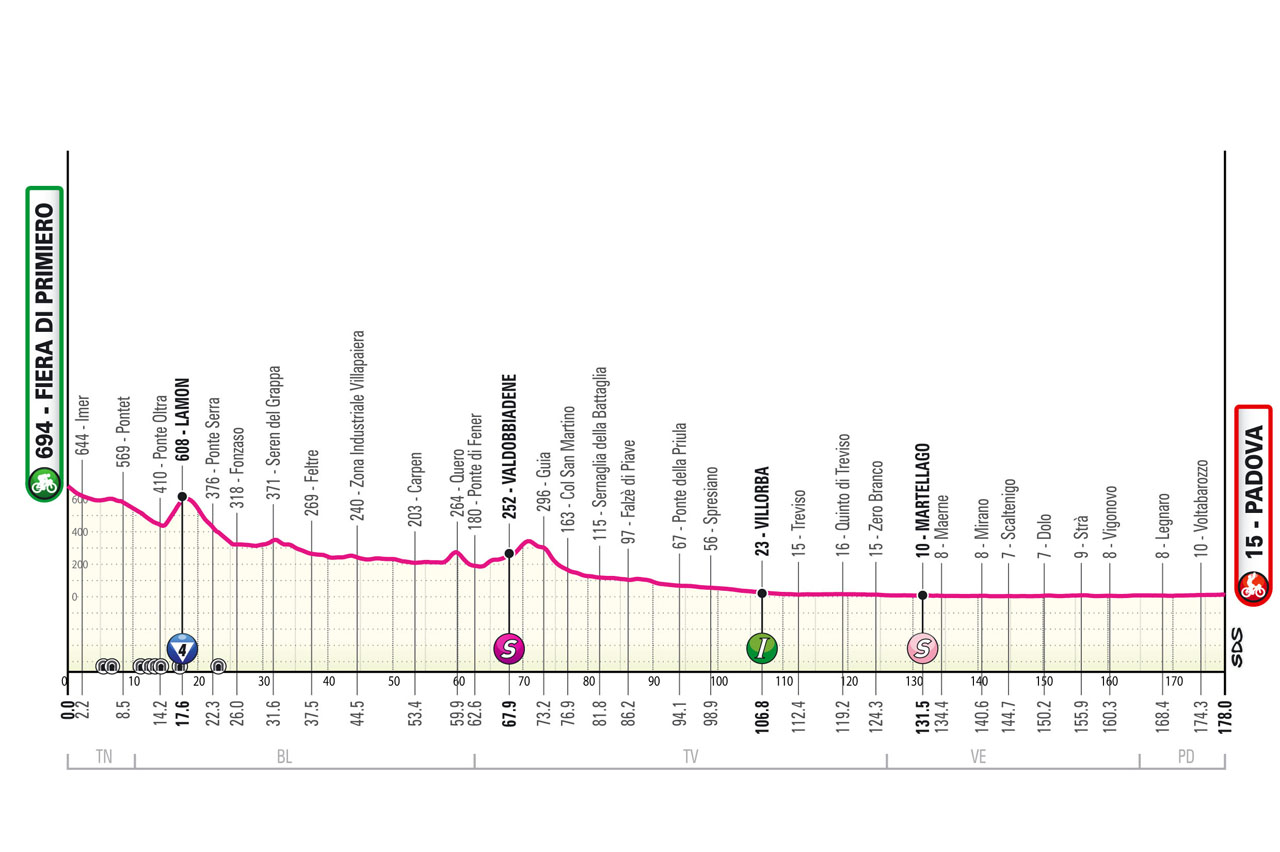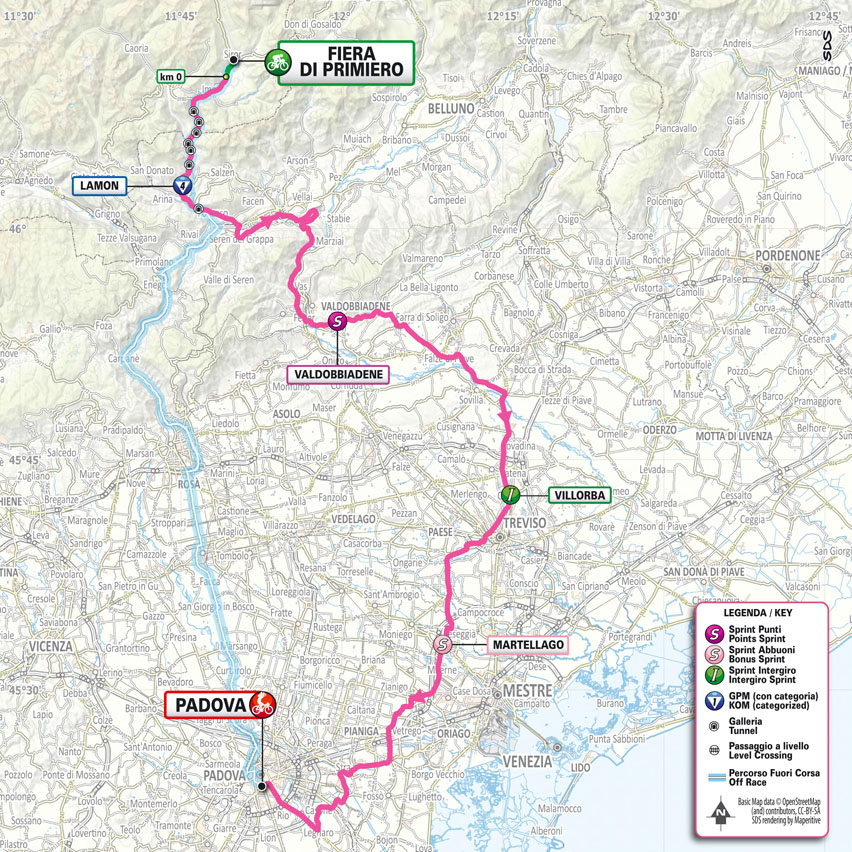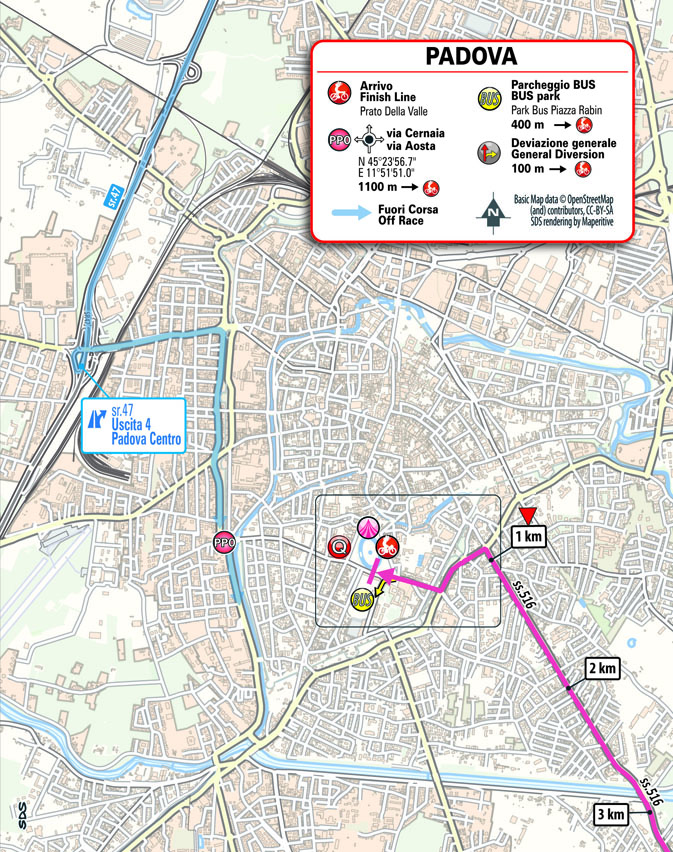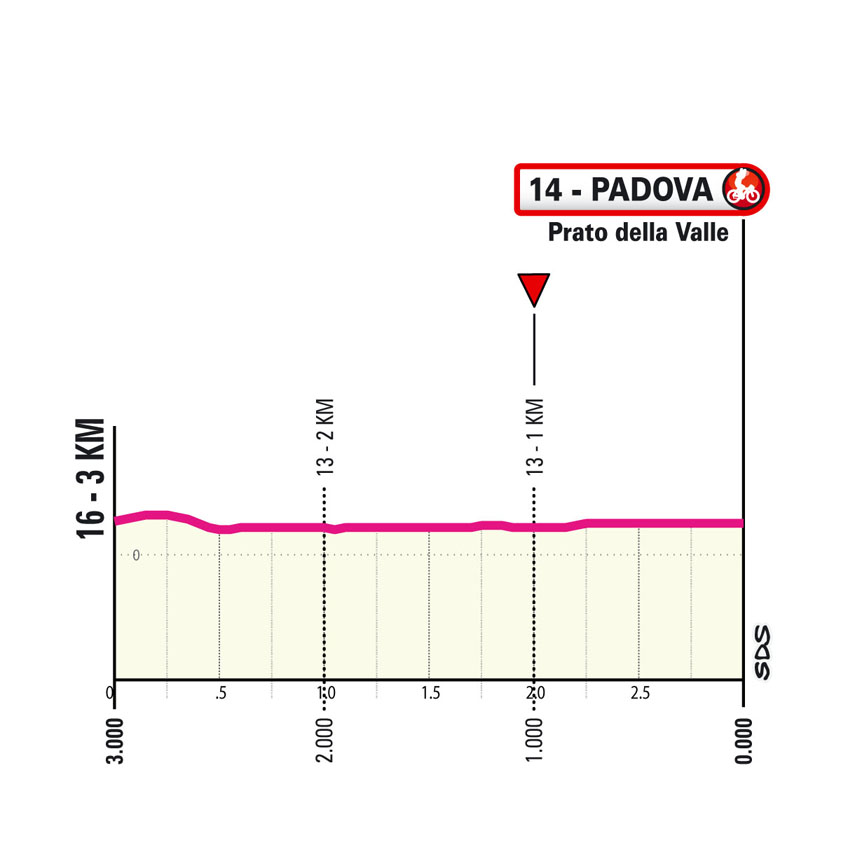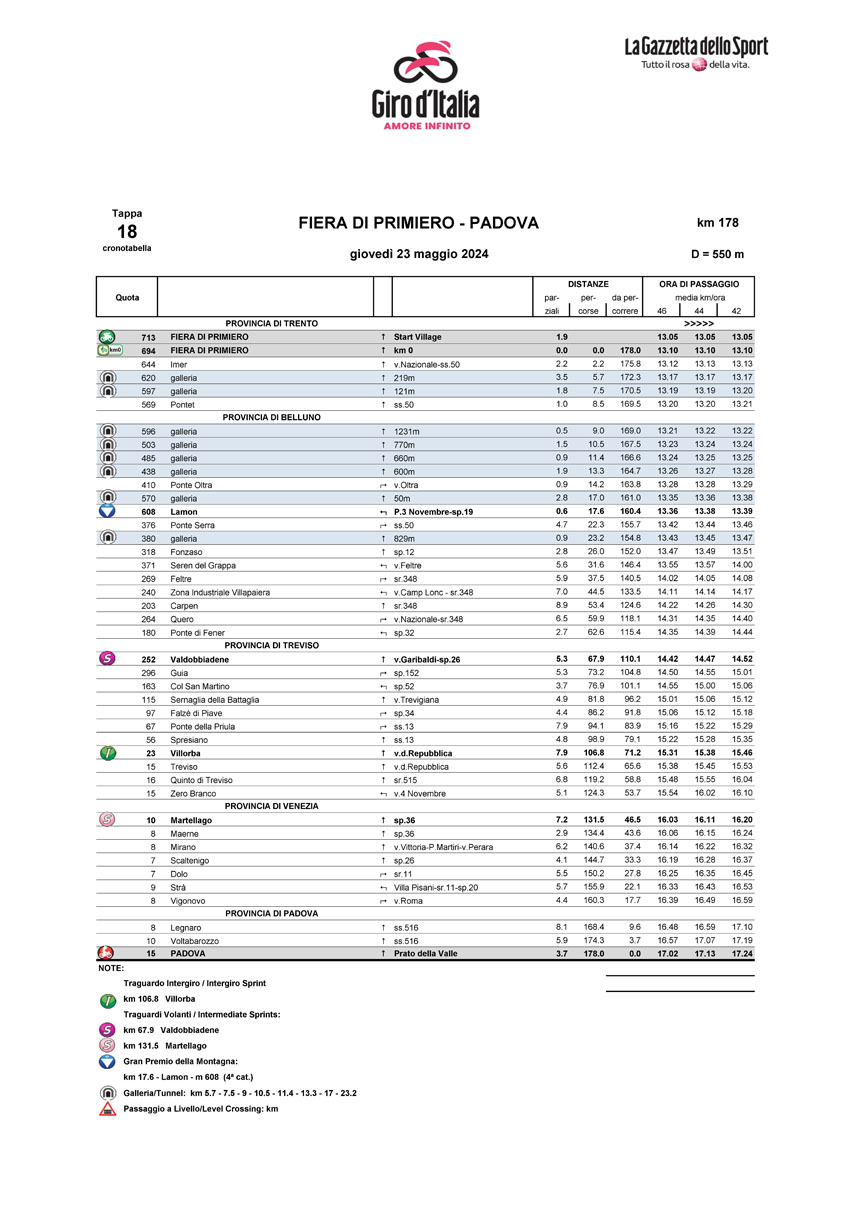profile
map
technical info
This stage features a single, rather modest climb in the opening half of the route (the KOM of Lamon) followed by about 150 km of slightly downhill false flat. The roads are mostly straight with varying carriageway widths, interspersed with built-up areas and the usual traffic obstacles.
Last kilometres
The last flat kilometres are characterised by two bends in the last kilometre. The last wide bend leads into Prato della Valle. The finishing straight measures 450 m in length and 9 m in width.
start / finish
final kilometres
itinerary timetable
tourist info
Host city:
Fiera di Primiero
Overview
The small village of Fiera di Primiero lies at the foot of the Pale di San Martino, the largest massif of the Dolomites, at the confluence of the Cismon and Canali rivers, in the eastern part of Trentino. Famous in the past for the wealth of its mines, it became the trade and administrative centre of the entire valley in the 15th century. Today it is a beautiful mountain village, located at an altitude of 730 metres.
Local Cusine
- Tosela: made every morning from freshly milked milk, it is usually served with polenta and sausage (luganega).
- Botiro di Malga cheese from Primiero: in the local dialect “botiro” means butter and, during the Serenissima period, the best butter sold in Venice came from the alpine pastures of Primiero. The Botiro di malga has an intense colour ranging from straw yellow to gold; its aroma is moderately aromatic, with quite lively floral and herbaceous notes. It has a soft consistency and is easily spreadable.
- Carne Fumada di Siror: smoked beef to be eaten raw.
Wine and other drinks
Although beer is not a typical product of Trentino, at the beginning of the 20th century the Premiata Birreria Valserena brewery, based in Siror, used to produce 5,000 hectolitres a year. The experience is taken up today by the BioNoc’ craft brewery (multi-awarded at European level), which produces non-pasteurised, unfiltered, re-fermented craft beers sold in bottles.
Points of Interest
- The Primiero valley: it consists of three municipalities: Imer, Mezzano and Primiero San Martino di Castrozza (which a few years ago incorporated the villages of Fiera di Primiero, Transacqua, Tonadico and Siror). The valley is surrounded by three mountain groups: to the north the Pale di San Martino, to the west the Lagorai and to the south the Vette Feltrine. The town of Fiera di Primiero represents the administrative, economic and commercial centre of the entire valley and boasts a number of historically important buildings such as the Palazzo delle Miniere and the Archpriest’s Church of Santa Maria Assunta, both dating back to the Gothic period.
- The Vanoi Valley: characterised by evocative and still wild territories, this valley offers a lush and fascinating landscape. Canal San Bovo is the main town and the seat of the municipality. Services such as the library, pharmacy, tourist information office and the Vanoi Ecomuseum are located here. Not far away are the villages of Cicona, Prade and Zortea, from where visitors can continue on to the Lozen Valley and the stunning Lake Calaita. On the other side of the mountain is the village of Ronco, while further north lies the village of Caoria.
- San Martino di Castrozza: it is a tourist resort located in the upper Primiero valley in eastern Trentino. The village lies in a green meadowy basin, surrounded by the Paneveggio-Pale di San Martino Park. Numerous peaks belonging to the Pale group, the largest of all the Dolomites, are visible from the village. Among these, the Cimon della Pala, the Vezzana, Sass Maor, the Val di Roda peak, and the Madonna peak certainly deserve a mention. For mountain and sports enthusiasts, this is the ideal destination: in winter, this town offers all sorts of snow-related activities one can dream of. In summer, outdoor activities range from classic hikes at all altitudes, to the Agility Forest Adventure Park and Bike Arena trails, Nordic walking, and fun playgrounds for children’s recreation and adult relaxation. Various events follow one another with a variety worthy of the best tourist resorts. On top of that, the wide accommodation and gastronomic offer is nothing short of excellent.
- Pale di San Martino: this is the largest chain of the Dolomites, with an extension of approximately 240 km2, located partly in eastern Trentino and partly in the province of Belluno. It extends in the area between Primiero (Cismon, Canali and Travignolo valleys), the Biois Valley and Agordino. The term “Pala” derives from the name that was used locally to refer to the banks and grassy slopes at the base of the chain. By extension, it later came to define the entire massif.
Padua
Overview
Padua is located east in the Po Valley, about 10 km north of the Euganean Hills and about 20 km west of the Venice Lagoon and is crossed by the Brenta and Bacchiglione rivers. It is known as the city of Saint Anthony. Whether you visit it from the water, stroll through the historic centre or take the time to discover its green surroundings by bicycle, Padua will definitely never let you down.
Points of Interest
Waterways: to fully appreciate Padua, a view of the city from the water, a source of richness and variety of landscape since ancient times, is a must. A classic excursion is by burchiello (a typical boat whose use dates back to the 18th century) on the Riviera del Brenta, starting with an exploration of the city’s waterways and ending with a visit to some of the Venetian villas, famous summer residences of 18th-century Venetian nobles, rich in frescoes.
University City: the University of Padua, with its more than 800 years of history, is a hub of excellent academic activities. With its 70,000 enrolled students, 2,200 lecturers and more than 13,000 graduates each year, it has long been at the top of the main national and international rankings for the quality of its teaching, research and services. The important cultural offer and the liveliness of the University’s entertainment proposals reflect positively on the energy of the entire city.
Historical centre: the completely pedestrian historic centre of Padua is a true jewel and a symbol of the city, featuring art galleries, museums, the Botanical Garden, the Scrovegni Chapel and the frescoes of the 14th century UNESCO World Heritage Site, but also historic shops and monumental palaces, churches and its gardens: getting lost in beauty is really easy in this city and, perhaps, it is the best way of visiting it.
The Botanical Garden of the University of Padua: created in 1545, it has been a World Heritage site since 1997 not only because it is the oldest in the western world but also because it is the only one that still retains its original form and location.
The 14th-century Fresco Cycles of Padua: inscribed on the Unesco World Heritage List in 2021, it consists of 8 locations that, starting from the Scrovegni Chapel, Giotto’s masterpiece, narrate a century of fresco art that led European art towards modernity.
The Basilica of Saint Anthony: it is one of the most famous and visited sanctuaries in the world, with an average of 6.5 million visitors per year. In addition to housing the precious relics of one of the most beloved figures of Christianity, it is also a place that preserves art treasures from every era, beginning with its construction in the first half of the 13th Century.











